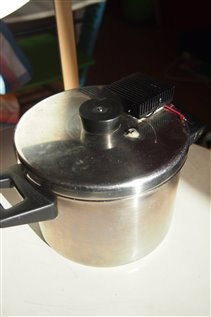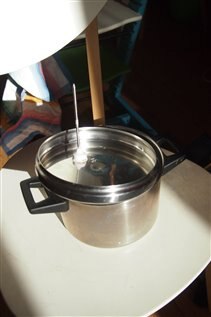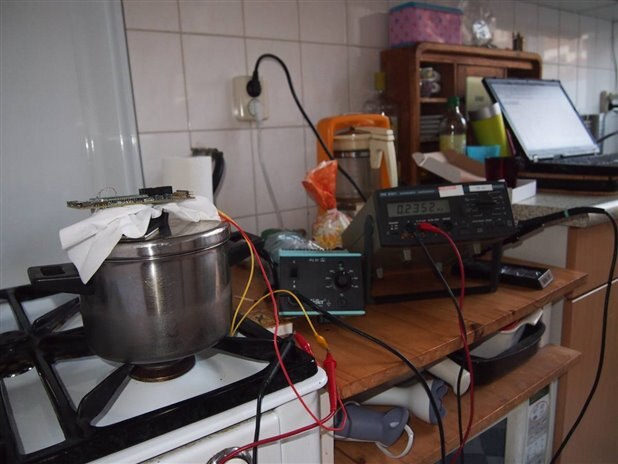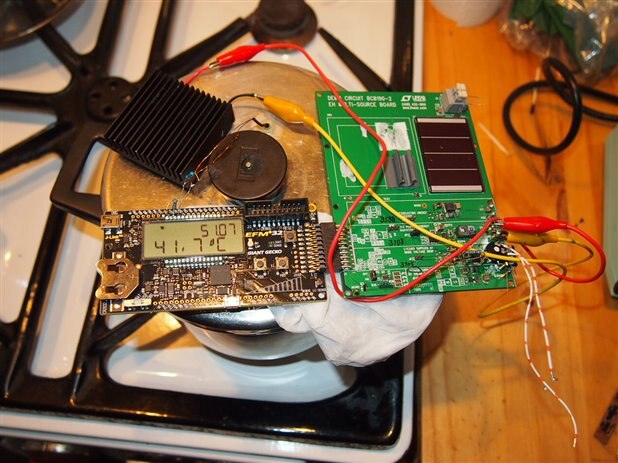Harvesting: the final frontier... It feels like I've just manouvered my egg-spaceship to a place that had to be explored; after months of travelling through low-power switchmode fields and changing my warp-core throug all low-power modes I finally put it all together; I'm harvesting energy and using that energy to do a complex calculation on the microcontroller.
The pan
Here you can see how I prepared my egg pan; on the top I mounted the heatsink and TEG I took from the demo board (mounted as shown at the bottom of this post). I then drilled a hole through the lid, and glued the temperature probe I took from the thermometer that got dissected in another post. This is my basic setup; energy will be generated by the temperature difference between the inside and outside of the pan, and this will be used to measure the water temperature. This info will then be used to calculate the temperature of the egg that just got inserted into the water.
Calibrating the temperature probe
My last post got no response; I think it was going a bit too much into detail, and was more about the temperature measurement than about the harvesting. Still, I think it is important to show that the energy made available by the harvesting principle can do something useful. So I'll tell a bit more about the calibration. I took two measurements to determine what my temperature probe was doing; one with ice cubes immersed in water (0°C) and the other with boiling water (100°C). I tweaked the numbers in the formulae I put into the firmware a bit to shift the measurement values to be more or less correct at these temperatures.
My resistance measurement had been right, I determined that at the boiling point the resistance was indeed indicating a temperature of 106°C. This has a very big effect on the 'boiling time' of an egg; to get a firm yolk, you'll need it to become 90°C, which will happen much faster at 106°C water temperature than at 100°C.
I double checked the measurement of my STK board with my faithful Philips multimeter. Here I'm cooling down....
And here I'm cooking! The board was still at the breakpoint I set when I was freezing, thus indicating 8.2°C.....
Harvesting:
And here it is; everything working together! The water temperature is 51.07°C (cooling down from cooking, very nice to see that this can already provide enough energy!), and the virtual egg yolk temperature has raised from 20°C to 41.7°C, and rising....
Phew....
I am SO glad this worked out in the end; I have been taking a look at several options for energy harvesting, and most of the times I was pretty disappointed to see the hurdles I had to take. Maybe this subject was just too hard to get a good prototype design in just 2 months. I would have loved to make a custom PCB with the needed electronics on it, which would be about the area of the heatsink, instead of bulging across the lid of the pan. In the end I chose to use the LTC3108 over the LTC3105. The latter has a nice option for matching the input impedance, and is able to generate a higher output current, but fortunately I can use the LTC3108 because the energy requirement is so low. The benefit of the LTC3108 for me is that it starts at a lower voltage.
Honestly: I would have loved and would have hated to continue this RoadTest Challenge; it took up a lot of time, but on the other hand I feel I've just started to scratch the surface of all possibilities. I would have loved to go deeper into the switching topologies, or route my own circuit for the converter. I would have loved to dive deeper into the possibilities of the GiantGecko. And I'm very happy that next week is the deadline of this project, and that I have more time for projects that were put aside the last months!
What designs could be made from this technology? Obviously: egg timers. Another way of using a setup like this would be cooking clocks that could be set for each pan separately. And finally, I think this could be great for monitoring / steering processes where temperature or pressure control is required and no electricity is available (natural disaster area, refugee camps, ...). Many processes can be monitored by looking at the current pressure, temperature or other physical gauge. What I tried to accomplish here was to show that integrating the heat can be calculated, thus saving fuel, or giving better control over your process. While I'm cooking eggs, others must have other uses in mind; sterilizing water and brewing beer has been mentioned before....
What's next? I'll cook an egg and make a small video of the design!





